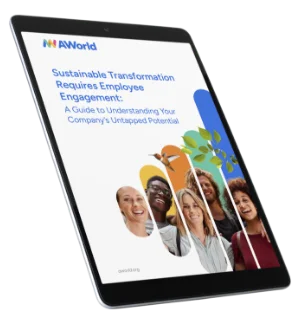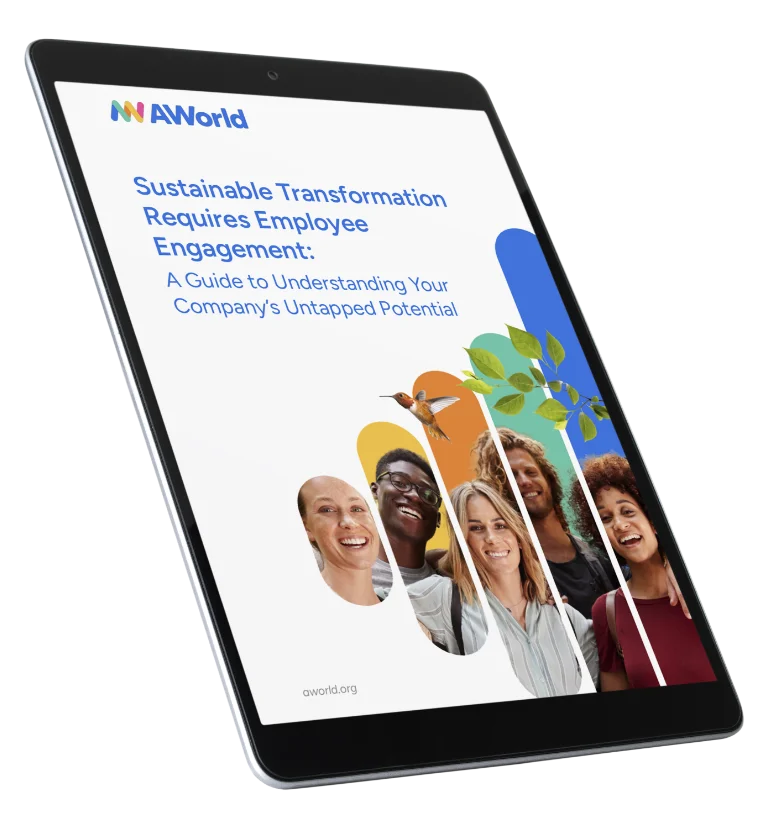As concerns about climate change and other ecological challenges have intensified, the concept of sustainability has never been more important for companies, individuals and governments around the world.
In this context, effective sustainability communication is crucial for future success.. In this article, we will take an in-depth look at the topic of sustainability communication, its role in business practices and the best strategies for coming across as effective and credible. Keep reading!
Table of Contents
- What is sustainability communication?
- Why is it important to communicate sustainability at corporate level?
- The 4 pillars of sustainability communication
- Strategies for effective sustainability communication
- Sustainability communication: avoid greenwashing and greenhushing
- Reports to provide evidence of sustainability communication
- AWorld: the platform to support sustainability communication
What is sustainability communication?
Sustainability communication is a strategy that companies implement once they have integrated sustainability into their operations and strategic activities, and which involves conveying sustainability initiatives, goals and results to a diverse range of stakeholders.
Sustainability communication, however, is not just about publicizing a company’s efforts, but about embedding environmental and social values into the very fabric of the organization and its narrative. This ensures that a company’s sustainable strategies are transparent, understood and appreciated by all stakeholders, from employees to consumers, from investors to the community at large. Sustainability communication is a tool for companies to show their commitment to a sustainable future and to differentiate themselves in a market that increasingly values corporate responsibility.
Why is it important to communicate sustainability at corporate level?
Sustainability communication has gained significant importance for companies due to four key factors:
Responding to growing consumer demand
Today’s consumers are increasingly aware of and concerned about environmental and social issues and thus, companies are called upon to demonstrate their commitment to these values. Effective communication of sustainability efforts builds trust and credibility with customers, enhancing reputation and brand loyalty.
Involve and motivate employees
It is not just about external communication; within the company, sustainability communication plays a key role in engaging and motivating employees, promoting a culture of sustainability. This also helps to attract and retain talent willing to work for responsible and conscious companies.
Comply with global environmental regulations
Efforts to communicate sustainability allows companies to comply with increasing regulatory requirements and stay ahead in a competitive market. It is an essential tool for companies to demonstrate their commitment to having a positive impact on society and the environment, thus aligning their goals with the broader goals of sustainable development.
Meeting investors’ expectations
Investors have also begun to evaluate companies based on their sustainability policies and practices, in addition to their financial performance. Clear and transparent communication of sustainability efforts helps reassure investors that the company is well positioned for the future, mitigating risks and capitalizing on sustainability-related opportunities. This is particularly relevant in a context of growing interest in socially responsible investing (SRI) and environmental, social and governance (ESG) criteria.
The 4 pillars of sustainability communication
Successful sustainability communication is based on four fundamental pillars: authenticity, transparency, involvement and consistency. These are not mere buzzwords, but concrete strategies that guide towards effective communication.
Authenticity: companies must align the messages they convey about sustainability with actual practices. This means that when a company claims to have reduced its carbon footprint, it must have verifiable actions and policies to back up this claim. Authenticity is about ensuring that any sustainability claim is supported by real, tangible efforts and that the company’s values are consistently reflected in its actions, policies and decisions.
Transparency: companies must openly share detailed information about sustainability initiatives, including successes and failures. It means providing stakeholders with access to data and reporting that clearly illustrate the environmental and social impact of the company’s activities. Transparency also includes admitting the challenges faced in implementing sustainable practices and what the company is doing to overcome them.
Engagement: effective sustainability communication is interactive. This means that it involves the active involvement of stakeholders – employees, customers, investors and communities – in sustainability initiatives. Engagement can take many forms, such as interactive digital platforms for feedback, community sustainability programmes, employee-led green initiatives or customer surveys on sustainability practices. This pillar is about creating a two-way conversation in which stakeholders feel heard and involved in the company’s sustainability journey.
Consistency: sustainability communication must be regular and continuous. It is not enough to announce a major sustainability initiative once and then remain silent. Consistent communication involves regular updates on progress, challenges and future plans. It means integrating sustainability messages into all aspects of corporate communication, from annual reports to social media posts, ensuring that the company’s commitment to sustainability remains a visible and integral part of its brand identity.
Strategies for effective sustainability communication
Implementing effective sustainability communication requires an approach that combines authenticity, clarity, personalisation and visual storytelling.
Here are some strategies to help avoid the most common pitfalls:
Integrating sustainability with corporate brand identity
Sustainability initiatives should be a natural extension of the corporate brand, not an isolated element. This means ensuring that initiatives align seamlessly with core brand values and communications, creating a cohesive narrative that reflects the essence of the company.
Clarity and simplicity of the message
It is crucial to clearly define the scope and depth of the communication. It is advisable to avoid over-complicating messages and instead focus on conveying sustainability initiatives in a direct and easily understood manner.
Personalization and relatability in storytelling
Sustainability stories must be short and, at the same time, relatable. This means that communication must be personalized so that it resonates with the audience’s experiences and emotions, making the sustainability journey something they can connect with on a personal level.
Using images to simplify complex concepts
It is advisable to use visual elements to make complex sustainability concepts more understandable, such as infographics, graphs and images, which effectively communicate data and ideas in an engaging and accessible way.
Commitment to honesty
It is crucial to be honest and transparent in sustainability communication, sharing truthful and verified information about sustainability initiatives and results.
Communication tailored to different audiences
There is no one-size-fits-all approach to sustainability communication. Different segments of a company’s audience may be engaged through different channels and respond to different types of messages. It is important to understand where different audiences are most active and what kind of content resonates with them, and then tailor the communication strategy accordingly.
Sustainability communication: avoid greenwashing and greenhushing
In the field of sustainability communication, companies often find themselves navigating between two conflicting challenges: greenwashing and greenhushing. Greenwashing, a term born of deceptive practices, occurs when companies exaggerate or falsify their sustainability credentials. It consists of a superficial representation of environmental friendliness, often without substantive actions to back it up. This approach has come under increasing scrutiny as consumers and stakeholders have become more environmentally conscious.
On the other hand, there is the less discussed but equally significant problem of greenhushing. This phenomenon occurs when companies, despite having made genuine progress in the field of sustainability, choose to downplay or even keep quiet about their achievements. The reasons behind greenhushing are numerous. Companies, for example, may fear that their efforts are not comprehensive enough to be publicized or they may view their sustainability strategies as a competitive secret to be kept hidden.
However, greenhushing can be counterproductive. By not communicating their real sustainability efforts, companies miss the opportunity to position themselves as leaders in the sustainable market. This silence can lead to decreased consumer confidence, reduced investor interest and a lack of employee engagement.
It is therefore essential that companies strike the right balance. Avoiding both greenwashing and greenhushing, companies should aim for honest and transparent communication about their sustainability journey.
Reports to provide evidence of sustainability communication
Providing evidence of sustainability communication is as important as the communication itself. And this is precisely where effective reporting comes in, offering tangible proof of the company’s commitment to sustainability. These reports should be comprehensive and describe not only successes, but also challenges and areas for improvement. They should follow global standards and frameworks such as the Global Reporting Initiative (GRI) or the UN Sustainable Development Goals (SDGs) to ensure credibility and comparability.
Sustainability reports should be clear, honest and transparent, and provide stakeholders with a true picture of the company’s sustainability efforts. They must include measurable data and indicators, case studies and stories that show the company’s impact.
Furthermore, these reports must be accessible and designed not only for experts but for all stakeholders, including customers, employees and the general public.
AWorld: the platform to support sustainability communication
AWorld is a revolutionary platform that enables companies to significantly improve their sustainability communication process. It offers a comprehensive suite of tools and capabilities that enable companies to effectively monitor, measure and communicate their sustainability efforts. With AWorld, companies can engage their stakeholders more effectively and interactively, showing their sustainability efforts in a tangible and relatable way.
The platform provides access to engaging content, tracks sustainability metrics and promotes stakeholder engagement. But that’s not all: it also offers insights and analysis, helping companies understand the impact of their communications and continuously improve their strategies. AWorld is more than just a tool: it is a partner in a company’s sustainability journey, providing the support and resources needed to communicate effectively, inspire action and make a difference in the world. Discover AWorld.





